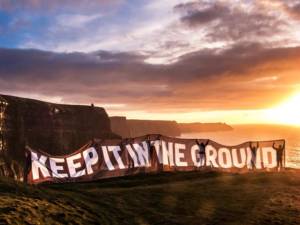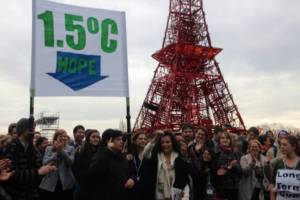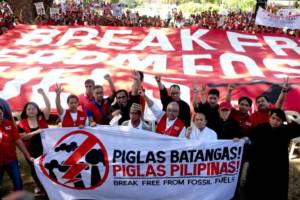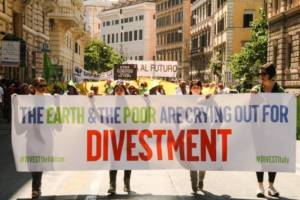Pretty much every government on the planet committed in Paris last year to hold global temperature rise ‘well below 2 °C’, aiming for 1.5 °C. We already know that there is a massive gap between these goals and governments’ actual plans for action. But what would need to happen to meet these goals and avoid tipping us into runaway climate change?

Carbon we can still emit to limit global warming to 1.5 °C: 200 GT CO2
…but there is some uncertainty if even that is too much
Scenarios for how we can meet the 1.5 °C target leave us with as little as 200 gigatonnes of CO2 (IPCC), and maybe less, to release into the atmosphere as of 2016. We’re currently emitting around 40 GtCO2 per year (fossil fuels plus land use change).
Scientist no longer talk about keeping warming below 1.5 °C. They talk about returning warming to below 1.5 °C. All 1.5 °C scenarios involve an ‘overshoot’ to up to 1.7 °C before cooling back down again.
This ‘drawdown’ is supposed to be achieved, in part, by carbon capture and storage, also known as carbon capture and sequestration (CCS). CCS is currently neither readily available nor economically viable. Even if CCS technology was deployed under a best-case scenario (nearly 3,800 CCS projects running by 2050), it would only start taking out emissions after 2030 and extend the carbon budget by about 125 Gt only (source: Carbon Tracker, Unburnable carbon 2013).
In other words, as of now we’ve just about run out of our carbon budget left for even a 50% chance of meeting the 1.5 °C target. From now on, we would have to draw down every tonne of carbon we emit.

Carbon budget left to limit global temperature rise to 2 °C: 470 GtCO2
Even for any sort of chance to meet the 2 °C target, emissions need to peak now and decline precipitously. For a chance of at least 66%, we can emit no more than 470 GtCO2 from 2015 onwards (source: Nature: Differences between carbon budget estimates unravelled). This is the lowest number in a range of several budget scenarios that goes up to 1020 Gt, and is accounting for emissions of greenhouse gases other than CO2 such as methane.
If you’re wondering what this means, in practice, it certainly means no new fossil anything. No new fossil fuel power plants, no new extraction projects, no new pipelines, no new drilling permits, no new fossil fuel financing. It also means massive fossil fuel production decreases.
Fossil fuel companies reserves: somewhere between 2,734 and 5,385 GtCO2
Regardless of any of this, fossil fuel companies are still looking for more and more coal, oil and gas to burn.
Carbon reserves are difficult to pin down. They are self-reported by the industries and are subject to economic feasibility — meaning significant reserves could fall out of the ‘proven reserves’ category when they are expensive to extract and oil prices drop, for example. Based on calculations from the IPCC (Assessment report 5 – working group 3, page 525), the carbon reserves fossil fuel companies currently report, add up to somewhere between 2,734 and 5,385 GtCO2 – way, way more than we can ever burn.
When we did the math back in 2012, we found that 80% of fossil fuel reserves need to be kept underground. At this point, 80% might actually be inadequate given the fast dwindling carbon budget and the growing fossil fuel reserves.
So now what?
The various figures and scenarios above are helpful to get an understanding of the scientific realities we’re facing, but they are merely points of reference rather than distinct markers.
Climate chaos has landed long ago for many people in different parts of the world and global temperature rise of 1.5 °C will mean even more destruction than we’re already seeing.
It’s the impacts of climate change we’re witnessing today that mandate urgent action now. This is not an issue that we can leave for the ‘second half of the century’, 2030 or even 2020. We simply need to keep fossil fuels in the ground as much as possible, starting now. Our actions today will determine how much carbon we emit and how bad climate change is going to get.
We have little reason to hope that governments or the fossil fuel companies will take the action we urgently need. It’s up to ordinary citizens to take action to keep the coal, oil and gas we simply cannot burn in the ground and build the community-based renewable energy future that is within reach. And it’s these ordinary people joining together that give us reason for hope.
If all these figures around carbon budgets left you feeling discouraged, head over to breakfree2016.org and you’ll find images of people around the world joining together in an unprecedented wave of escalated mass actions to keep coal, oil and gas in the ground. There is a global movement of people resisting fossil fuels, to halt new projects and shut down existing ones also pushing investors to cut their ties to the industry while going ahead and building the solutions we already have at hand. Social movements throughout history have brought about tremendous change that often seemed impossible at the time.
It’s uncertain how this story will end for us. But if there ever was a time to put up a fight, it’s certainly now. Join us!




By Brett Fleishman & Melanie Mattauch